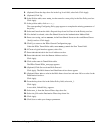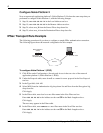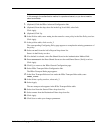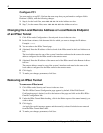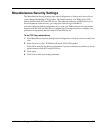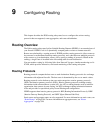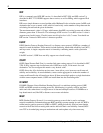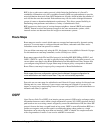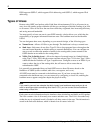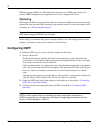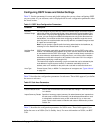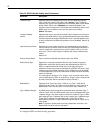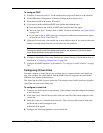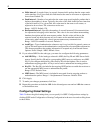
Nokia Network Voyager for IPSO 4.0 Reference Guide 353
BGP is also a path-vector routing protocol, which limits the distribution of a firewall’s
reachability information to its peer or neighbor firewalls. BGP uses path attributes to provide
more information about each route. BGP maintains an AS path, which includes the number of
each AS that the route has transited. Path attributes may also be used to distinguish between
groups of routes to determine administrative preferences. This allows greater flexibility in
determining route preference and achieves a variety of administrative ends.
BGP supports two basic types of sessions between neighbors: internal (IBGP) and external
(EBGP). Internal sessions run between firewalls in the same autonomous systems, while
external sessions run between firewalls in different autonomous systems.
Route Maps
Route maps are used to control which routes are accepted and announced by dynamic routing
protocols. Use route maps to configure inbound route filters, outbound route filters and to
redistribute routes from one protocol to another.
You can define route maps only using the CLI, this feature is not available in Network Voyager.
For information on route map commands, see the CLI Reference Guide.
Route maps support both IPv4 and IPv6 protocols, including RIP, BGP, RIPng, OSPFv2, and
OSPFv3. BGP-4++ policy can only be specified using route maps. For the other protocols, you
can use either route maps or the Route Redistribution and Inbound Route Filters features that
you configure using Network Voyager. Route map for import policy corresponds to Inbound
Route Filters; route map for export policy corresponds to Route Redistribution.
Note
Route maps offer more configuration options than the Network Voyager configuration for
route redistribution and inbound route filters. They are not functionally equivalent.
Protocols can use route maps for redistribution and Network Voyager settings for inbound route
filtering and vice versa. However, if one or more route maps are assigned to a protocol (for
import or export) any corresponding Network Voyager configuration (for route redistribution or
inbound route filters) is ignored.
OSPF
Open Shortest Path First (OSPF) is an interior gateway protocol (IGP) used to exchange routing
information between routers within a single autonomous system (AS). OSPF calculates the best
path based on true costs using a metric assigned by a network administrator. RIP, the oldest IGP
protocol chooses the least-cost path based on hop count. OSPF is more efficient than RIP, has a
quicker convergence, and provides equal-cost multipath routing where packets to a single
destination can be sent using more than one interface. OSPF is suitable for complex networks
with a large number of routers. It can coexist with RIP on a network.



